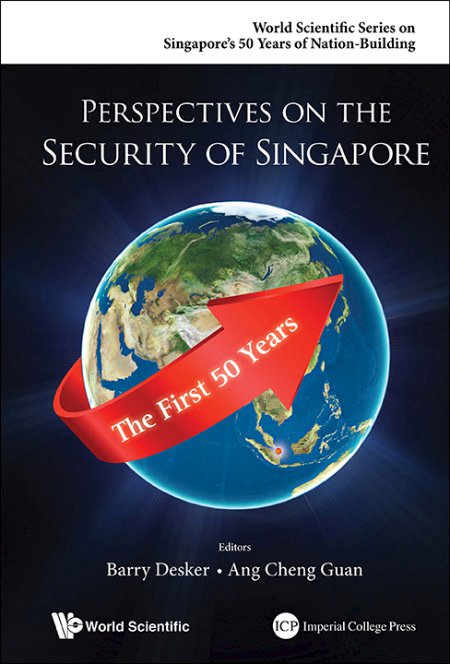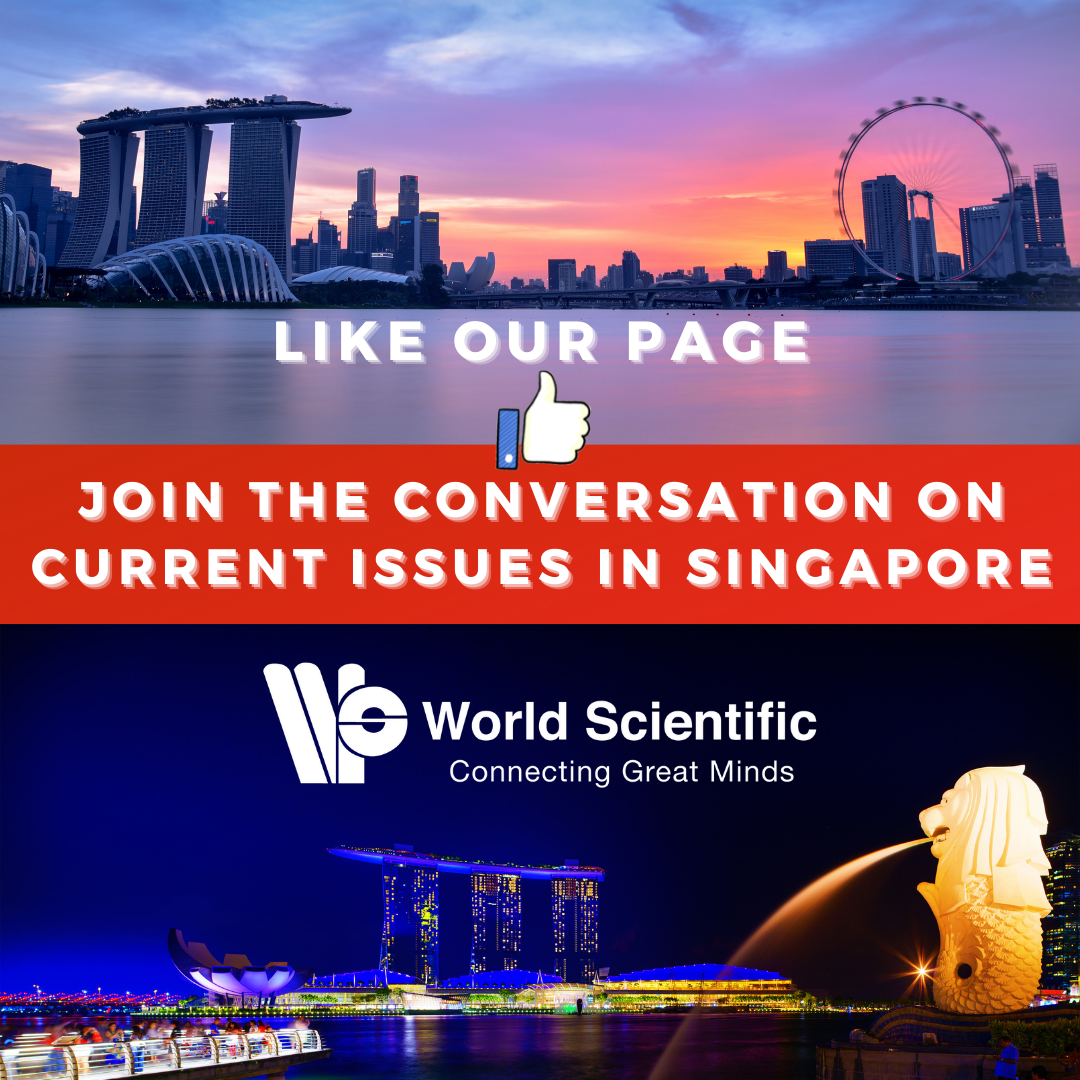Cookies Notification
System Upgrade on Tue, May 28th, 2024 at 2am (EDT)
Existing users will be able to log into the site and access content. However, E-commerce and registration of new users may not be available for up to 12 hours.For online purchase, please visit us again. Contact us at customercare@wspc.com for any enquiries.

World Scientific Series on Singapore's 50 Years of Nation-Building
Perspectives on the Security of Singapore
- Edited by:
- Barry Desker (S. Rajaratnam School of International Studies, NTU, Singapore) and
- Cheng Guan Ang (S. Rajaratnam School of International Studies, NTU, Singapore)
Perspectives on the Security of Singapore: The First 50 Years explores the security of Singapore in the last 50 years and its possible trajectories into the future. This volume brings together the diverse perspectives of a team of academics with different expertise, ranging from history to political science to security studies with a common interest in Singapore. The book is further boosted by the recollections of key civil servants involved with foreign affairs and defence, such as S R Nathan, Peter Ho, Bilahari Kausikan and Philip Yeo.
Sample Chapter(s)
Chapter 1: Introduction (72 KB)
Contents:
- Introduction
- Part 1:
- Singapore's Conception of Security (Ang Cheng Guan)
- National Security and Singapore: An Assessment (Norman Vasu and Bernard Loo)
- Deliquescent Security Threats: Singapore in the Era of Hyper-Globalisation (Alan Chong)
- Singapore and Global Governance: Free-Rider or Responsible Stakeholder? (Tan See Seng)
- The Challenge of Strategic Intelligence for the Singapore Armed Forces (Kwa Chong Guan)
- Desecuritisation and after Desecuritisation: The Water Issue in Singapore–Malaysia Relations (S R Joey Long)
- Singapore's Security in the Context of Singapore–Malaysia–Indonesia Relations (Bilveer Singh)
- Singapore's Relations with Malaysia and Indonesia (Theophilus Kwek and Joseph Chinyong Liow)
- International Missions of the Singapore Armed Forces: How Far Would You Go? (Katie Tan and Ong Weichong)
- Why the FPDA Still Matters to Singapore (Ralf Emmers)
- Singapore in ASEAN's Quest toward a Security Community (Mely Caballero-Anthony)
- Singapore and the Great Powers (Khong Yuen Foong)
- The Changing Terrorist Threat Landscape in Singapore (Rohan Gunaratna)
- Managing Religious Diversity in Singapore: Context and Challenges (Mohammad Alami Musa and Mohamed Imran Mohamed Taib)
- Part 2:
- Personal Reminiscences
- Safeguarding Singapore's Security: Defence and Diplomacy (S R Nathan)
- Organising for National Security — The Singapore Experience (Peter Ho)
- Pragmatic Adaptation, Not Grand Strategy, Shaped Singapore Foreign Policy (Bilahari Kausikan)
- Dr Goh Keng Swee and the Building of Singapore's Defence Industrial Capability (Philip Yeo)
- Conclusion: Strategic Certainties Facing Singapore in 2065 (Barry Desker)
Readership: Undergraduate and graduate students, researchers and academics, and general public interested in security studies in general and in Singapore.
FRONT MATTER
- Pages:i–xvi
https://doi.org/10.1142/9789814689342_fmatter
The following sections are included:
- Contents
- About the Contributors
Introduction
- Pages:xvii–xxi
https://doi.org/10.1142/9789814689342_0001
This collection of essays is specially prepared to mark the 50th anniversary of Singapore's independence. The unifying theme is “Singapore's Security” in its broadest sense and dimension. Written by scholars and associates of the S. Rajaratnam School of International Studies (RSIS), the book explores security issues and concerns of the nation-state over the last 50 years with a closing chapter that looks into the future. The book showcases the range of expertise in the School which at its inception as the then-Institute of Defence and Strategic Studies (IDSS) in July 1996 was funded by the Ministry of Defence with the aim of developing proficiency in understanding the evolving conception of security and its implications for Singapore in the post-Cold War world. IDSS has, since January 2007, evolved into the S. Rajaratnam School of International Studies but remains an integral component of the School. The School is named after Singapore's first Foreign Minister, Mr S. Rajaratnam, and appropriately so, given that foreign policy and defence are very much two sides of the same coin…
Part 1
Chapter 1: Singapore's Conception of Security
- Pages:3–19
https://doi.org/10.1142/9789814689342_0002
This chapter attempts to describe and contextualise Singapore's conception of security as articulated by its political leadership from 1965 to the present based on a number of key speeches, parliamentary debates and writings over the last 50 years which, in the view of this author, are worth revisiting and remembering. It shows that Singapore's security as conceived by its political leaders has been consistent throughout the last 50 years. From very early on, their understanding of the concept of security has been comprehensive and not narrowly conceived as just physical or territorial security and the use of force, although in Singapore's formative years, that was the immediate concern…
Chapter 2: National Security and Singapore: An Assessment
- Pages:21–43
https://doi.org/10.1142/9789814689342_0003
The following sections are included:
- Introduction
- Understanding National Security
- Singapore's National Security: Drivers and Passengers of Change
- Assessing Singapore's National Security
- Conclusion
- Notes
Chapter 3: Deliquescent Security Threats: Singapore in the Era of Hyper-Globalisation
- Pages:45–64
https://doi.org/10.1142/9789814689342_0004
Singapore's security paradigm in the 2000s is an experiment in progress. Pre-existing doctrines expressed as extensions of deterrence or of locking down homeland security are increasingly anachronistic, even if the government of Singapore maintains that they are not irrelevant. Instead, this chapter proposes that Singapore has entered the phase of deliquescent security. What is to be protected and the source of the threat are both mobile and existential, even embedded in the design of taken-for-granted flows of labour, tourism, trade, finance and information. The object and referent of security under globalising conditions are therefore liquid; they dissolve, or exist in a latent state, until ignited by a confluence of flows that challenge the very essence of a Singaporean national identity. This is what I label the deliquescent security paradigm. Incidentally, it can only come into existence following the cumulative effects of conventional external security and domestic security against revolutionary subversion. Conventional external security presupposes a visible and deterrable enemy, armed with tanks, aircraft and a recognisable army threatening to cross one's borders with impunity. If the enemy attacks one's territory with non-uniformed “volunteers” and agents provocateur hidden in legitimate political parties and other social organisations, then deterrence fails to address the root of the threat. As Richard Clutterbuck put it in one of the earliest studies of Singapore's domestic security contextualised during the Cold War, the threat was revolution from within. It was a Leninist stratagem: “an attempt to gain control of student and labour organisations and of a leading political party…; the process being assisted by strikes, student demonstrations and riots.” Clutterbuck also correctly appraised Singapore's mostly urban context for domestic security: “City people live from week to week, relying for next week's food on work, wages and a continuing system of wholesale and retail distribution; they also fear the failure of public services, such as water, sewerage, electric power and transport; they therefore have a vested interest in law and order; faced by chaos and a choice between two claimants to power, they will rally to the one which gives them most confidence of a return to normal life — as the Bolsheviks did in Petrograd in 1917.” The point about urban destabilisation is relevant to this chapter in the sense that by 1965, given the successive waves of urbanisation of the transient population fostered by British colonialism, the nascent Singaporean population has gradually evolved the desire for a multifaceted security that transcends the mere protection of borders. Even during the Cold War, as Clutterbuck pointedly suggests, there was already a yearning for system security, supply security, occupational security and governmental legitimacy. The communists were a viable rival to the People's Action Party (PAP) government insofar as they were promising the mostly urban population stability in their lives and a secure identity in living in a modernising city-state.
Chapter 4: Singapore and Global Governance: Free-Rider or Responsible Stakeholder?
- Pages:65–86
https://doi.org/10.1142/9789814689342_0005
The notion that Singapore “punches above its weight” has become commonplace. Reportedly boasting the highest gross domestic product (GDP) per capita in the world today and projected to maintain its pole position up till 2050, Singapore's economic success and its strategies to ensure its success have invited accusations that the city-state has continually reaped the benefits of global governance but contributed little to it. For example, Singapore's ostensible efforts at “leapfrogging” and transcending the ASEAN region — its “dual track” approach of negotiating multilateral and bilateral free trade agreements (FTAs) is the offending instance in question — have led critics to dismiss Singapore as a “free-rider” in global governance. A similar charge has been made concerning “Singaporisation,” a convenient label for critics in regard to the form of “assertive regionalism” that has purportedly been adopted by pro-independence parties in the Basque and Catalan parts of Spain. Fairly or otherwise, some Europeanists see such enthusiasm for the (as they see it) Singapore model of preferential economic regionalism as evidence of the lack of “real political responsibility” in post-crisis Europe…
Chapter 5: The Challenge of Strategic Intelligence for the Singapore Armed Forces
- Pages:87–102
https://doi.org/10.1142/9789814689342_0006
Singapore was born by constitutional fiat on 9 August 1965 as a defenceless city-state vulnerable to external predatory powers in a rough neighbourhood beset by wars and communist insurgencies. Facing the prospect of the withdrawal of British armed forces from east of Suez, particularly from their bases in Singapore, and uneasy at the prospect of being dependent on the Malaysian armed forces for its protection, Singapore embarked on an accelerated build-up of its own armed capability, with the help of Israeli advisers and experts from Commonwealth countries. That build-up, including the enlistment and training of National Servicemen to provide the mind and muscle of the nascent army, proceeded at a sharp pace under the leadership of Dr Goh Keng Swee, the first Defence Minister…
Chapter 6: Desecuritisation and after Desecuritisation: The Water Issue in Singapore–Malaysia Relations
- Pages:103–120
https://doi.org/10.1142/9789814689342_0007
On 16 November 1970, the Singaporean government dispatched a sharply worded memorandum to the Malaysian government. The diplomatic note remonstrated against Kuala Lumpur's delay in informing the Asian Development Bank (ADB) that Malaysia would back Singapore's plans to enhance the capacity of the reservoirs in Johor to supply more water to the island. Singapore had in April 1968 sought the bank's support to develop a reservoir in Kranji and to expand the water works in Johor. Under the terms of the 1962 water agreement signed between the government of Johor and the city council of Singapore (an arrangement incidentally guaranteed by the 1965 Separation Agreement), Singapore was entitled to extract up to 250 million gallons of raw water daily from the Johor River. By the late 1960s, Singapore was drawing some 30 million gallons per day from the Johor river, and planned to extract more to meet the needs of its people and expanding industries. A loan from the ADB would permit Singapore to expand the existing waterworks in Johor and pump more water to the island. But the bank would only agree to release the funds if the Malaysian government endorsed the proposal. Dragging their feet, the federal and Johor authorities in Malaysia were ostensibly “disinclined to let Singapore make off with water that the developments round Johore Bahru might need”. The Malaysians were also miffed that the Singaporean government had apparently submitted its plans to the ADB without first consulting them…
Chapter 7: Singapore's Security in the Context of Singapore–Malaysia–Indonesia Relations
- Pages:121–134
https://doi.org/10.1142/9789814689342_0008
The following sections are included:
- Introduction
- Ties That Bind and Unbind — The Key Determinants
- Challenges in the Singapore–Malaysia–Indonesia Relationships
- Singapore–Malaysia–Indonesia: The Elusive Peace Dividend and Rising Insecurity
- The Road Ahead
- Notes
Chapter 8: Singapore's Relations with Malaysia and Indonesia
- Pages:135–151
https://doi.org/10.1142/9789814689342_0009
The Malay word for “neighbourhood”, kejiranan, not only implies a geographical “quarter” or “precinct” but also, in a more communal sense, an interdependent society of individuals and interests. Singapore's immediate neighbourhood, held together by both history and proximity, contains three states whose relations have been complex at best, and contentious at worst. From the — political and personal — tumult of separation, through the violence of Konfrontasi and the trials of early cooperation, the intrigues which have shaped the attitudes of Singapore, Malaysia, and Indonesia toward each other are often murky to their own inhabitants and impervious to the outside observer. Yet, in addition to hosting the world's highest cargo traffic in their ports, the three form the core of many new security initiatives in the Asian-Pacific region, and front a region of increasing political salience in today's world…
Chapter 9: International Missions of the Singapore Armed Forces: How Far Would You Go?
- Pages:153–172
https://doi.org/10.1142/9789814689342_0010
The following sections are included:
- Introduction
- Deploying around the World to Protect Our Home
- Challenges in Sustaining Commitment to OOTW
- International Missions — “Not a Soldier's Job, but Only a Soldier Can Do It”
- HADR: Finding a Regional Response and Niche Role
- Trends Analysis
- Notes
Chapter 10: Why the FPDA Still Matters to Singapore
- Pages:173–187
https://doi.org/10.1142/9789814689342_0011
The following sections are included:
- Introduction
- History of the FPDA
- The FPDA's Continuing Relevance to Singapore
- Conclusion
- Notes
Chapter 11: Singapore in ASEAN's Quest toward a Security Community
- Pages:189–205
https://doi.org/10.1142/9789814689342_0012
The following sections are included:
- Introduction
- Singapore in ASEAN's Quest of Building Regional Peace and Security
- ASEAN's Turn to Multilateralism: Charting Relations with Major Powers
- Moving ASEAN Political and Security Cooperation to a Higher Plane
- Conclusion
- Notes
Chapter 12: Singapore and the Great Powers
- Pages:207–228
https://doi.org/10.1142/9789814689342_0013
A common refrain in Singapore's foreign policy towards the great powers — confined to the United States (US) and China in this essay — is that it does not want to choose between them. Singapore is far from alone in articulating this strategic preference: many of its ASEAN and Asian-Pacific neighbours, including US military allies such as Australia and Thailand, have voiced similar inclinations. This essay seeks to probe a little deeper into the “not wanting to choose” discourse to make three related points. First, I argue that Singapore has already chosen; it made a choice early on — in favour of the US — soon after the British withdrawal East of Suez. Second, I suggest that that choice has served Singapore well. Third, I argue that the dilemma Singapore faces after 15 years of a very successful foreign policy (vis-à-vis the great powers) is whether to stick with America, or gravitate towards China, given the shifting power distribution in Asia. Singapore's actions in recent years suggest that it continues to strongly favour America when it comes to military security; on the economic and political-diplomatic fronts, however, it appears to be more even-handed in engaging the US and China. We conclude with an observation: the fact that Singapore is a Chinese-majority state, constrains, rather than facilitates, how far it can move towards the China bandwagon.
Chapter 13: The Changing Terrorist Threat Landscape in Singapore
- Pages:229–252
https://doi.org/10.1142/9789814689342_0014
The following sections are included:
- Introduction
- The Context
- Background
- Al-Qaeda-Centric Threat — Phase One
- Al-Qaeda-Centric Threat — Phase Two
- IS-Centric Threat — Phase One
- IS-Centric Threat — Phase Two
- State and Societal Response
- Conclusion
- Notes
Chapter 14: Managing Religious Diversity in Singapore: Context and Challenges
- Pages:253–276
https://doi.org/10.1142/9789814689342_0015
The following sections are included:
- Introduction
- The Early Years, 1965–1980: Religion as a Partner in Building Social Cohesion
- The Period of Religious Resurgence, 1980–1990: Religion as Potential Conflict
- Rapid Globalising Phase, 1990s Onwards: Economic Imperatives as a Driving Force
- Post-9/11: Global Conflicts and Security Issues
- Conclusion
- Notes
- References
Part 2: Personal Reminiscences
Chapter 15: Safeguarding Singapore's Security: Defence and Diplomacy
- Pages:279–283
https://doi.org/10.1142/9789814689342_0016
Singapore has enjoyed peace and security the past 50 years of its independence. From being virtually defenceless when we separated from Malaysia on 9 August 1965, Singapore has been able to build its armed forces comprising a full-fledged Army, seagoing Navy and modern air force, comprising 45,000 to 50,000 well-trained and equipped soldiers, sailors and airmen, with over 250,000 reservists who can be mobilised in short order. Looking back at the growth and development of our small island nation from a third world entrepot port to a first world global trading hub and financial centre, I believe we succeeded in doing so because we had been able to build up our defence capability in tandem with our economic development, while pursuing a foreign policy that sought a maximum number of friends and maintaining the freedom to be ourselves as an independent nation…
Chapter 16: Organising for National Security — The Singapore Experience
- Pages:285–294
https://doi.org/10.1142/9789814689342_0017
The following sections are included:
- Introduction
- Pre-Independence Focus on Internal Security
- Post-Independence Focus on External Defence
- The Early Phase — The Ministry of Interior and Defence
- The British Military Withdrawal
- MID No Longer Fit for Purpose
- Beyond Military Defence — Total Defence
- The Whole-of-Government Approach in National Security
- Beyond Total Defence — Total Security
- Challenges of the Whole-of-Government Approach
- The Rise of Transnational Terrorism
- Organising to Confront Transnational Terrorism
- Organisation for National Security with the Rise of Transnational Terrorism
- Organising for Black Swans
- Establishing the National Security Coordination Secretariat
- Resilience and Strategic Surprise
- The Use of Technology to Enhance Organisation
- Conclusion
- Note
Chapter 17: Pragmatic Adaptation, Not Grand Strategy, Shaped Singapore Foreign Policy
- Pages:295–307
https://doi.org/10.1142/9789814689342_0018
The following sections are included:
- Seeking Security through Diplomacy
- Cold War Conflict and Diplomacy
- Absurd Diplomacy
- Regional Security Approaches
- Significance of ARF
- SEANWFZ and Right of Reservation
- Post-Cold War Security Challenge
- A Symmetrical Naval Equation
- Impact of China's Re-Emergence
Chapter 18: Dr Goh Keng Swee and the Building of Singapore's Defence Industrial Capability: A First-Person Account of the Early Challenges in Building the Republic's Defence Industry
- Pages:309–316
https://doi.org/10.1142/9789814689342_0019
I have largely been associated with the Economic Development Board (EDB). Few people, however, know that I actually began my career with the Ministry of Defence (MINDEF). In this, I am very fortunate to have worked with Dr Goh Keng Swee, the man who built the economy and the defence capability of Singapore. Indeed, it all started with Dr Goh. A tribute by the Defence Science Organisation (DSO) in 2002 describes him accurately as the architect, engineer and hand-craftsman of modern Singapore. He transformed Singapore of the 1960s into today's gleaming, ultra-modern capital of industry, finance, commerce and communications. But Dr Goh also felt that economic confidence and progress were built on a nation's ability to provide security and defence for its people. He projected that future outcomes would depend on the capability of a national service (NS) force, well-trained and equipped with the most advanced technology of the day. Starting from scratch, Dr Goh built an army, navy and air force capable of achieving national security and deterring a wide range of threats. This was the Singapore Armed Forces (SAF)…
Conclusion: Strategic Certainties Facing Singapore in 2065
- Pages:317–329
https://doi.org/10.1142/9789814689342_0020
This article attempts to look at Singapore in 2065, after 100 years of independence. Crystal ball gazing is a testing task. Our projections of trends even five or 10 years into the future involve weighing the influence of different alternative courses of action and an assessment of the most likely developments. The further down the road we go, the more we move away from describing the world as we know it today. What is striking is how much our imaginations are prisoners of the present. Even though we want to look beyond today and aim to conceive of a world which will unfold in the years ahead, we are shaped by our memories and experiences. Linear projections are common. We struggle to grapple with the possibility of discontinuities, of changes which break existing moulds. At the same time, our natural optimism leads us to plot a future which highlights Singapore's role at the forefront of nation-states, a beacon of economic growth, social development and political stability. When we discuss the possibility of changes, the tendency is to think in terms of incremental shifts. Few consider the possibility of paradigm shifts, which should not be ignored.
BACK MATTER
- Page:330
https://doi.org/10.1142/9789814689342_bmatter
The following section is included:
- World Scientific Series on Singapore's 50 Years of Nation-Building: Forthcoming (continued from page ii)

Ambassador Barry Desker is Distinguished Fellow and Bakrie Professor of Southeast Asia Policy at the S. Rajaratnam School of International Studies, Nanyang Technological University, Singapore. He is a Member of the Presidential Council for Minority Rights, Singapore and a Member of the Board of Directors of the Lee Kuan Yew Exchange Fellowship. He was CEO of the Singapore Trade Development Board (1994–2000) and was Singapore's Ambassador to Indonesia (1986–1993). He was the founding Dean of RSIS (2007–2014) and was Director, Institute of Defence and Strategic Studies (2000–2014). A President's Scholar, he was educated at the University of Singapore, University of London and Cornell University. He was awarded an honorary doctorate by Warwick University in 2012 and by the University of Exeter in 2013.

Ang Cheng Guan is presently Head of Graduate Studies at the S. Rajaratnam School of International Studies, Nanyang Technological University, Singapore. He is the author of Vietnamese Communist Relations with China and the Second Indo-China Conflict, 1956–1962 (Jefferson: MacFarland, 1997; reprinted in paperback, 2012); The Vietnam War from the Other Side: The Vietnamese Communists' Perspective (London: RoutledgeCurzon, 2002; paperback 2006); its sequel, Ending the Vietnam War: The Vietnamese Communists' Perspective (London: RoutledgeCurzon, 2004; paperback 2006); Southeast Asia and the Vietnam War (London: Routledge, 2010); Lee Kuan Yew's Strategic Thought (London: Routledge, 2013); and Singapore, ASEAN and the Cambodia Conflict, 1979–1991 (Singapore: NUS Press, 2013). He was a Gerald R Ford Foundation Research Grant Award recipient (Fall 2005), Fulbright Singapore Researcher award recipient (2006–2007) and a Woodrow Wilson Public Policy Scholar (2006–2007). He is currently working on two book projects — Southeast Asia and the Cold War, 1945–1991: An International History and its sequel, Southeast Asia and the Post-Cold War: The First Thirty Years.
Sample Chapter(s)
Chapter 1: Introduction (72 KB)






















